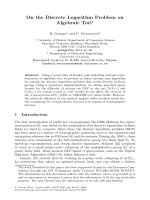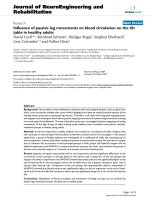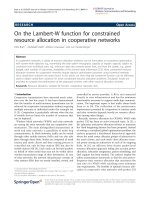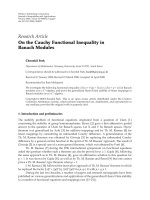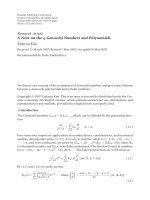ON THE EXISTENCE OR THE ABSENCE OF GLOBAL SOLUTIONS OF THE CAUCHY CHARACTERISTIC PROBLEM FOR SOME pdf
Bạn đang xem bản rút gọn của tài liệu. Xem và tải ngay bản đầy đủ của tài liệu tại đây (623.67 KB, 18 trang )
ON THE EXISTENCE OR THE ABSENCE OF GLOBAL
SOLUTIONS OF THE CAUCHY CHARACTERISTIC PROBLEM
FOR SOME NONLINEAR HYPERBOLIC EQUATIONS
S. KHARIBEGASHVILI
Received 20 October 2004
For wave equations with power nonlinearity we investigate the problem of the existence
or nonexistence of global solutions of the Cauchy characteristic problem in the light cone
of the future.
1. Statement of the problem
Consider a nonlinear wave equation of the type
u :=
∂
2
u
∂t
2
−∆u = f (u)+F, (1.1)
where f and F are the given real functions; note that f is a nonlinear and u is an unknown
real function, ∆ =
n
i=1
∂
2
/∂x
2
i
.
For (1.1), we consider the Cauchy characteristic problem on finding in a truncated
light cone of the future D
T
: |x| <t<T, x = (x
1
, ,x
n
), n>1, T = const > 0, a solution
u(x,t) of that equation by the boundary condition
u|
S
T
= g, (1.2)
where g is the given real function on the characteristic conic surface S
T
: t =|x|, t ≤ T.
When considering the case T =+∞ we assume that D
∞
: t>|x| and S
∞
=∂D
∞
: t =|x|.
Note that the questions on the existence or nonexistence of a global solution of the
Cauchy problem for semilinear equations of type (1.1) with initial conditions u|
t=0
= u
0
,
∂u/∂t|
t=0
= u
1
have been considered in [1, 2, 6, 7, 8, 10, 13, 14, 15, 16, 17, 18, 22, 23, 26,
30, 31].
As for the characteristic problem in a linear case, that is, for problem (1.1)-(1.2)when
the right-hand side of (1.1) does not involve the nonlinear summand f (u), this prob-
lem is, as is known, formulated correctly, and the global solvability in the corresponding
spaces of functions takes place [3, 4, 5, 11, 25].
Below we will distinguish the particular cases of the nonlinear function f
= f (u),
when problem (1.1)-(1.2) is globally solvable i n one case and unsolvable in the other one.
Copyright © 2006 Hindawi Publishing Corporation
Boundary Value Problems 2005:3 (2005) 359–376
DOI: 10.1155/BVP.2005.359
360 The Cauchy characteristic problem
2. Global solvability of the problem
Consider the case for f (u) =−λ|u|
p
u,whereλ =0andp>0 are the given real numbers.
In this case (1.1) takes the form
Lu :=
∂
2
u
∂t
2
−∆u =−λ|u|
p
u + F, (2.1)
where for convenience we introduce the notation L = .Asisknown,(2.1)appearsin
the relativistic quantum mechanics [13, 24, 28, 29].
For the sake of simplicity of our exposition we will assume that the boundary condi-
tion (1.2) is homogeneous, that is,
u|
S
T
= 0. (2.2)
Let
◦
W
1
2
(D
T
,S
T
) ={u ∈ W
1
2
(D
T
):u|
S
T
= 0},whereW
1
2
(D
T
)istheknownSobolev
space.
Remark 2.1. The embedding operator I :
◦
W
1
2
(D
T
,S
T
) →L
q
(D
T
) is the linear continuous
compact operator for 1 <q<2(n +1)/(n −1) when n>1[21, page 81]. At the same
time, Nemytski’s operator K : L
q
(D
T
) → L
2
(D
T
), acting by the formula Ku=−λ|u|
p
u,
is continuous and bounded if q ≥ 2(p +1) [19, page 349], [20, pages 66–67]. Thus if
p<2/(n −1), that is, 2(p +1)< 2(n +1)/(n −1), then there exists the number q such that
1 < 2(p +1)≤q<2(n +1)/(n −1), and hence the operator
K
0
= KI :
◦
W
1
2
D
T
,S
T
−→ L
q
D
T
(2.3)
is continuous and compact and, more so, from u
∈
◦
W
1
2
(D
T
,S
T
)followsu ∈ L
p+1
(D
T
). As
is mentioned above, here, and in the sequel it will be assumed that p>0.
Definit ion 2.2. Let F ∈L
2
(D
T
)and0<p<2/(n −1). The function u ∈
◦
W
1
2
(D
T
,S
T
)issaid
to be a strong generalized solution of the nonlinear problem (2.1), (2.2) in the domain D
T
if there exists a sequence of functions u
m
∈
◦
C
2
(D
T
,S
T
) ={u ∈
◦
C
2
(D
T
):u|
S
T
= 0} such
that u
m
→ u in the space
◦
W
1
2
(D
T
,S
T
)and[Lu
m
+ λ|u
m
|
p
u
m
] → F in the space L
2
(D
T
).
Moreover, the convergence of the sequence {λ|u
m
|
p
u
m
} to the function λ|u|
p
u in the
space L
2
(D
T
), as u
m
→ u in the space
◦
W
1
2
(D
T
,S
T
), follows from Remark 2.1, and since
|u|
p+1
∈ L
2
(D
T
), therefore on the strength of the boundedness of the domain D
T
the
function u ∈L
p+1
(D
T
).
Definit ion 2.3. Let 0 <p<2/(n −1), F ∈ L
2,loc
(D
∞
), and F ∈ L
2
(D
T
)foranyT>0. It is
said that problem (2.1), (2.2)isgloballysolvableifforanyT>0 this problem has a strong
generalized solution in the domain D
T
from the space
◦
W
1
2
(D
T
,S
T
).
S. Kharibegashvili 361
Lemma 2.4. Let λ>0, 0 <p<2/(n −1),andF ∈ L
2
(D
T
).Thenforanystronggeneralized
solution u ∈
◦
W
1
2
(D
T
,S
T
) of problem (2.1)-(2.2) in the domain D
T
the estimate
u
◦
W
1
2
(D
T
,S
T
)
≤
√
eTF
L
2
(D
T
)
(2.4)
is valid.
Proof. Let u ∈
◦
W
1
2
(D
T
,S
T
) be the strong generalized solution of problem (2.1)-(2.2). By
Definition 2.2 and Remark 2.1 there exists a sequence of functions u
m
∈
◦
C
2
(D
T
,S
T
)such
that
lim
m→∞
u
m
−u
◦
W
1
2
(D
T
,S
T
)
= 0,
lim
m→∞
Lu
m
+ λ
u
m
p
u
m
−F
L
2
(D
T
)
= 0.
(2.5)
The function u
m
∈
◦
C
2
(D
T
,S
T
) can be considered as the solution of the following prob-
lem:
Lu
m
+ λ
u
m
p
u
m
= F
m
, (2.6)
u
m
|
S
T
= 0. (2.7)
Here
F
m
= Lu
m
+ λ
u
m
p
u
m
. (2.8)
Multiplying both parts of (2.6)by∂u
m
/∂t and integrating with respect to the domain
D
τ
,0<τ≤T,weobtain
1
2
D
τ
∂
∂t
∂u
m
∂t
2
dxdt
−
D
τ
∆u
m
∂u
m
∂t
dxdt
+
λ
p +2
D
τ
∂
∂t
u
m
p+2
dxdt
=
D
τ
F
m
∂u
m
∂t
dxdt.
(2.9)
Let Ω
τ
:= D
T
∩{t = τ} and denote by ν = (ν
1
, , ν
n
,ν
0
) the unit vector of the outer
normal to S
T
\{(0, ,0,0)}. Taking into account (2.7)andν|
Ω
τ
= (0, ,0,1), integration
362 The Cauchy characteristic problem
by parts results easily in
D
τ
∂
∂t
∂u
m
∂t
2
dxdt =
∂D
τ
∂u
m
∂t
2
ν
0
ds =
Ω
τ
∂u
m
∂t
2
dx +
S
τ
∂u
m
∂t
2
ν
0
ds,
D
τ
∂
∂t
u
m
p+2
dxdt =
∂D
τ
u
m
p+2
ν
0
ds =
Ω
τ
u
m
p+2
dx,
D
τ
∂
2
u
m
∂x
2
i
∂u
m
∂t
dxdt =
∂D
τ
∂u
m
∂x
i
∂u
m
∂t
ν
i
ds−
1
2
D
τ
∂
∂t
∂u
m
∂x
i
2
dxdt
=
∂D
τ
∂u
m
∂x
i
∂u
m
∂t
ν
i
ds−
1
2
∂D
τ
∂u
m
∂x
i
2
ν
0
ds
=
∂D
τ
∂u
m
∂x
i
∂u
m
∂t
ν
i
ds−
1
2
S
τ
∂u
m
∂x
i
2
ν
0
ds−
1
2
Ω
τ
∂u
m
∂x
i
2
dx,
(2.10)
whence, by virtue of (2.9), it follows that
D
τ
F
m
∂u
m
∂t
dxdt =
S
τ
1
2ν
0
n
i=1
∂u
m
∂x
i
ν
0
−
∂u
m
∂t
ν
i
2
+
∂u
m
∂t
2
ν
2
0
−
n
j=1
ν
2
j
ds
+
1
2
Ω
τ
∂u
m
∂t
2
+
n
i=1
∂u
m
∂x
i
2
dx +
λ
p +2
Ω
τ
u
m
p+2
dx.
(2.11)
Since S
τ
is the characteristic surface,
ν
2
0
−
n
j=1
ν
2
j
S
τ
= 0. (2.12)
Taking into account that the operator (ν
0
(∂/∂x
i
) −ν
i
(∂/∂t)), i =1,2, , n, is the inter-
nal differential operator on S
τ
, by means of (2.7)wehave
∂u
m
∂x
i
ν
0
−
∂u
m
∂t
ν
i
S
τ
= 0, i =1,2, ,n. (2.13)
By (2.12)and(2.13), from (2.11)weget
Ω
τ
∂u
m
∂t
2
+
n
i=1
∂u
m
∂x
i
2
dx +
2λ
p +2
Ω
τ
u
m
p+2
dx =2
D
τ
F
m
∂u
m
∂t
dxdt. (2.14)
In the notation w(δ) =
Ω
δ
[(∂u
m
/∂t)
2
+
n
i=1
(∂u
m
/∂x
i
)
2
]dx, taking into account that
λ/(p +2)> 0 and also the inequality 2F
m
(∂u
m
/∂t) ≤ε(∂u
m
/∂t)
2
+(1/ε)F
2
m
which is valid
for any ε =const > 0, (2.14)yields
w(δ)
≤ ε
δ
0
w(σ)dσ +
1
ε
F
m
2
L
2
(D
δ
)
,0<δ≤ T. (2.15)
S. Kharibegashvili 363
From (2.15), if we take into account that the value F
m
2
L
2
(D
δ
)
as the function of δ is
nondecreasing, by Gronwall’s lemma [12, page 13] we find that
w(δ) ≤
1
ε
F
m
2
L
2
D
δ
expδε. (2.16)
Because inf
ε>0
(expδε/ε) = eδ, which is achieved for ε =1/δ,weobtain
w(δ) ≤eδ
F
m
2
L
2
(D
δ
)
,0<δ≤ T. (2.17)
From (2.17) in its turn it follows that
u
m
2
◦
W
1
2
(D
T
,S
T
)
=
D
T
∂u
m
∂t
2
+
n
i=1
∂u
m
∂x
i
2
dxdt
=
T
0
w(δ)dδ ≤ eT
2
F
m
2
L
2
(D
T
)
(2.18)
and hence
u
m
◦
W
1
2
(D
T
,S
T
)
≤
√
eT
F
m
L
2
(D
τ
)
. (2.19)
Here we have used the fact that in the space
◦
W
1
2
(D
T
,S
T
)thenorm
u
W
1
2
(D
T
)
=
D
T
u
2
+
∂u
∂t
2
+
n
i=1
∂u
∂x
i
2
dxdt
1/2
(2.20)
is equivalent to the norm
u
=
D
T
∂u
∂t
2
+
n
i=1
∂u
∂x
i
2
dxdt
1/2
, (2.21)
since from the equalities u|
S
T
= 0andu(x,t) =
t
|x|
(∂u(x, τ)/∂t)dτ,(x,t) ∈ D
T
, which are
valid for any function u ∈
◦
C
2
(D
T
,S
T
), in a standard way we obtain the following inequal-
ity [21, page 63]:
D
T
u
2
(x, t)dxdt ≤T
2
D
T
∂u
∂t
2
dxdt. (2.22)
By virtue of (2.5)and(2.8), passing to inequality (2.19) to the limit as m →∞,we
obtain (2.4). Thus the lemma is proved.
Remark 2.5. Before passing to the question on the solvability of the nonlinear problem
(2.1), (2.2), we consider this question for a linear case in the form we need, when in (2.1)
the parameter λ =0, that is, for the problem
Lu(x, t) =F(x,t), (x, t) ∈D
T
,
u(x,t) =0, (x,t) ∈S
T
.
(2.23)
364 The Cauchy characteristic problem
In this case for F ∈ L
2
(D
T
), we analogously introduce the notion of a strong gener-
alized solution u of problem (2.23) for which there exists the sequence of functions
u
m
∈
◦
C
2
(D
T
,S
T
), such that lim
m→∞
u
m
−u
◦
W
1
2
(D
T
,S
T
)
= 0, lim
m→∞
Lu
m
−F
L
2
(D
T
)
= 0.
It should be here noted that as we can see from the proof of Lemma 2.4,theapriori
estimate (2.4) is likewise valid for the strong generalized solution of problem (2.23).
Since the space C
∞
0
(D
T
) of finite infinitely differentiable functions in D
T
is dense in
L
2
(D
T
), for the given F ∈ L
2
(D
T
) there exists the sequence of functions F
m
∈ C
∞
0
(D
T
)
such that lim
m→∞
F
m
−F
L
2
(D
T
)
= 0. For the fixed m, if we continue the function F
m
by zero outside the domain D
T
and retain the same notation, we will find that F
m
∈
C
∞
(R
n+1
+
) for which suppF
m
⊂ D
∞
,whereR
n+1
+
= R
n+1
∩{t ≥ 0}. Denote by u
m
asolu-
tion of the Cauchy problem Lu
m
= F
m
, u
m
|
t=0
= 0, ∂u
m
/∂t|
t=0
= 0, which, as is known,
exists, is unique, and belongs to the space C
∞
(R
n+1
+
)[9, page 192]. As far as suppF
m
⊂ D
∞
,
u
m
|
t=0
= 0, ∂u
m
/∂t|
t=0
= 0, taking into account the geometry of the domain of depen-
dence of a solution of the wave equation, we obtain suppF
m
⊂ D
∞
[9, page 191]. Retain-
ing for the narrowing of the function u
m
to t he domain D
T
the same notation, we can
easily see that u
m
∈
◦
C
2
(D
T
,S
T
), and by virtue of (2.4)wehave
u
m
−u
k
◦
W
1
2
(D
T
,S
T
)
≤
√
eT
F
m
−F
k
L
2
(D
T
)
. (2.24)
Since the sequence {F
m
}is fundamental in L
2
(D
T
), the sequence {u
m
},owingto(2.24),
is likewise fundamental in the complete space
◦
W
1
2
(D
T
,S
T
). Therefore there exists the
function u ∈
◦
W
1
2
(D
T
,S
T
) such that lim
m→∞
u
m
−u
◦
W
1
2
(D
T
,S
T
)
= 0, and since Lu
m
= F
m
→
F in the space L
2
(D
T
), this function will, by Remark 2.5, be the strong generalized so-
lution of problem (2.23). The uniqueness of that solution from the space
◦
W
1
2
(D
T
,S
T
)
follows from the a priori estimate (2.4). Consequently, for the solution u of problem
(2.23)wecanwriteu
= L
−1
F,whereL
−1
: L
2
(D
T
) →
◦
W
1
2
(D
T
,S
T
) is the linear continuous
operator whose norm, by virtue of (2.4), admits the estimate
L
−1
L
2
(D
T
)→
◦
W
1
2
(D
T
,S
T
)
≤
√
eT. (2.25)
Remark 2.6. Taki n g into account (2.25)forF ∈ L
2
(D
T
), 0 <p<2/(n − 1) and also
Remark 2.1, it is not difficult to see that the function u
∈
◦
W
1
2
(D
T
,S
T
)isthestronggen-
eralized solution of problem (2.1)-(2.2)ifandonlyifu is the solution of the functional
equation
u =L
−1
−λ|u|
p
u + F
(2.26)
in the space
◦
W
1
2
(D
T
,S
T
).
We rew r i te (2.26)intheform
u =Au :=L
−1
K
0
u + F
, (2.27)
S. Kharibegashvili 365
where the operator K
0
:
◦
W
1
2
(D
T
,S
T
) → L
2
(D
T
)from(2.3) is, by Remark 2.1,acontinu-
ous and compact one. Consequently, by virtue of (2.25)theoperatorA :
◦
W
1
2
(D
T
,S
T
) →
◦
W
1
2
(D
T
,S
T
) is likewise continuous and compact. At the same time, by Lemma 2.4,forany
parameter τ ∈ [0,1] and any solution of the equation with the parameter u =τAu the a
priori estimate u
◦
W
1
2
(D
T
,S
T
)
≤ cF
L
2
(D
T
)
with the positive constant c, independent of u,
τ,andF,isvalid.
Therefore by Leray-Schauder theorem [32, page 375], (2.27), and hence problem (2.1)-
(2.2), has at least one solution u ∈
◦
W
1
2
(D
T
,S
T
).
Thus the following theorem is valid.
Theorem 2.7. Let λ>0, 0 <p<2/(n −1), F ∈ L
2,loc
(D
∞
),andF ∈L
2
(D
T
) for any T>0.
Then problem (2.1)-(2.2) is globally solvable, that is, for any T>0 this problem has the
strong generalized solution u ∈
◦
W
1
2
(D
T
,S
T
) in the domain D
T
.
3. Nonexistence of the global solvability
Below we will restrict ourselves to the case when in (2.1)theparameterλ<0 and the
space dimension n =2.
Definit ion 3.1. Let F ∈ C(D
T
). The function u is said to be a strong generalized con-
tinuous solution of problem (2.23)ifu ∈
◦
C(D
T
,S
T
) ={u ∈C(D
T
):u|
S
T
= 0} and there
exists a sequence of functions u
m
∈
◦
C
2
(D
T
,S
T
)suchthatlim
m→∞
u
m
−u
C(D
T
)
= 0and
lim
m→∞
Lu
m
−F
C(D
T
)
= 0.
We introduce into the consideration the domain D
x
0
,t
0
={(x,t) ∈ R
3
: |x| <t<t
0
−
|x −x
0
|} which for (x
0
,t
0
) ∈D
T
is bounded below by a lig ht cone of the future S
∞
with
the vertex at the origin and above by the light cone of the past S
−
x
0
,t
0
: t =t
0
−|x −x
0
| with
the vertex at the point (x
0
,t
0
).
Lemma 3.2. Let n
= 2, F ∈
◦
C(D
T
,S
T
). Then there exists the unique strong ge neralized con-
tinuous solution of problem (2.23) for which the integral representation
u(x, t)
=
1
2π
D
x,t
F(ξ, τ)
(t −τ)
2
−|x −ξ|
2
dξ dτ,(x, t) ∈D
T
, (3.1)
and the estimate
u
C(D
T
)
≤ cF
C(D
T
)
(3.2)
w ith the positive constant c, independent of F,arevalid.
Proof. Without restriction of generality, we can assume that the function F ∈
◦
C(D
T
,S
T
)is
continuous in the domain D
∞
such that F ∈
◦
C(D
∞
,S
∞
). Indeed, if (x,t) ∈D
∞
\D
T
,then
we can take F(x,t) =F((T/t)x,T). Let D
T,δ
: |x|+ δ<t<T,where0<δ= const < (1/2)T.
Obviously, D
T,δ
⊂ D
T
.SinceF ∈ C(D
T
)andF|
S
T
= 0, for some strongly monotonically
366 The Cauchy characteristic problem
decreasing sequence of positive numbers {δ
k
} there exists the sequence of functions {F
k
}
such that
F
k
∈ C
∞
D
T
,suppF
k
⊂ D
T,δ
k
, k =1,2, ,
lim
k→∞
F
k
−F
C(D
T
)
= 0.
(3.3)
Indeed, let ϕ
δ
∈ C([0,+∞)) be the nondecreasing continuous function of one vari-
able such that ϕ
δ
(τ) = 0for0≤ τ ≤2δ and ϕ
δ
(τ) = 1fort ≥ 3δ.Let
F
δ
(x,t) = ϕ
δ
(t −
|x|)F(x,t), (x,t) ∈D
T
.SinceF ∈C(D
T
)andF|
S
T
= 0, we can easily verify that
F
δ
∈ C
D
T
,supp
F
δ
⊂ D
T,2δ
,lim
δ→∞
F
δ
−F
C(D
T
)
= 0. (3.4)
Now we take advantage of the operation of averaging and let
G
δ
(x, t) =ε
−n
R
3
F
δ
(ξ,τ)ρ
x −ξ
ε
,
τ
ε
dξ dτ, ε =
√
2 −1
δ, (3.5)
where
ρ ∈C
∞
0
R
3
,
R
3
ρdxdt =1, ρ ≥ 0,
suppρ =
(x, t) ∈R
3
: x
2
+ t
2
≤ 1
.
(3.6)
From (3.4) and averaging properties [9, page 9] it follows that the sequence F
k
= G
δ
k
,
k = 1,2, , satisfies (3.3). Continuing the function F
k
by zero to the strip Λ
T
:0<t<T
and retaining the same notation, we have F
k
∈ C
∞
(Λ
T
), where suppF
k
⊂ D
T,δ
k
⊂ D
T
,
k = 1,2, Therefore, just in the same way as in proving Lemma 2.4, for the solution
of the Cauchy problem Lu
k
= F
k
, u
k
|
t=0
= 0, ∂u
k
/∂t|
t=0
= 0 in the strip Λ
T
which exists,
is unique, and belongs to the space C
∞
(Λ
T
), we have suppu
k
⊂ D
T
and, more so, u
k
∈
◦
C
2
(D
T
,S
T
), k =,1,2
On the other hand, since supp F
k
⊂ D
T
, F
k
∈ C
∞
(Λ
T
) for the solution u
k
of the Cauchy
problem, by the Poisson formula the integral representation [33, page 227]
u
k
(x, t) =
1
2π
D
x,t
F
k
(ξ,τ)
(t −τ)
2
−|x −ξ|
2
dξ dτ,(x, t) ∈D
T
, (3.7)
is valid and the estimate [33, page 215]
u
k
C(D
T
)
≤
T
2
2
F
k
C(D
T
)
(3.8)
holds.
By (3.4)and(3.8), the sequence {u
k
}⊂
◦
C
2
(D
T
,S
T
) is fundamental in the space
◦
C(D
T
,
S
T
) and tends to some function u for which, by virtue of (3.7), the representation (3.1)is
valid and the estimate (3.2)holds.Thuswehaveprovedthatproblem(2.23)issolvable
in the space
◦
C(D
T
,S
T
).
S. Kharibegashvili 367
As for the uniqueness of the strong generalized continuous s olution of problem (2.23),
it follows from the following reasoning. Let u ∈
◦
C(D
T
,S
T
)andF = 0 and there exists
the sequence of functions u
k
∈
◦
C
2
(D
T
,S
T
) such that lim
k→∞
u
k
− u
C(D
T
)
= 0,
lim
k→∞
Lu
k
C(D
T
)
=0. This implies that lim
k→∞
u
k
−u
L
2
(D
T
)
=0andlim
k→∞
Lu
k
L
2
(D
T
)
= 0. Since the function u
k
∈
◦
C
2
(D
T
,S
T
) can be considered as the strong generalized solu-
tion of problem (2.23)forF
k
= Lu
k
from the space
◦
W
1
2
(D
T
,S
T
), the estimate u
k
◦
W
1
2
(D
T
,S
T
)
≤
√
eTLu
k
L
2
(D
T
)
is valid according to Remark 2.5. Therefore lim
k→∞
Lu
k
L
2
(D
T
)
= 0
implies that lim
k→∞
u
k
◦
W
1
2
(D
T
,S
T
)
= 0, and hence lim
k→∞
u
k
L
2
(D
T
)
= 0. Taking into ac-
count the fact that lim
k→∞
u
k
−u
L
2
(D
T
)
= 0, we obtain u =0. Thus Lemma 3.2 is proved
completely.
Lemma 3.3. Let n =2, λ<0, F ∈
◦
C(D
T
,S
T
),andF ≥0. Then if u ∈C
2
(D
T
) is the classical
solution of problem (2.1 )-(2.2), then u ≥ 0 in the domain D
T
.
Proof. If u ∈ C
2
(D
T
) is the classical solution of problem (2.1)-(2.2), then u ∈
◦
C
2
(D
T
,
S
T
), and since F ∈
◦
C(D
T
,S
T
), the right-hand side G =−λ|u|
p
u + F of (2.1)belongsto
the space
◦
C(D
T
,S
T
). Considering the function u ∈
◦
C
2
(D
T
,S
T
) as the classical solution of
problem (2.23)forF =G, that is,
Lu =G, u|
S
T
= 0, (3.9)
it will, more so, be the strong generalized continuous solution of problem (3.9). There-
fore, taking into account that G ∈
◦
C(D
T
,S
T
), by Lemma 3.2, for the function u the inte-
gral representation
u(x,t) =−
λ
2π
D
x,t
|u|
p
u
(t −τ)
2
−|x −ξ|
2
dξ dτ + F
0
(x,t) (3.10)
holds. Here
F
0
(x, t) =
1
2π
D
x,t
F(ξ, τ)
(t −τ)
2
−|x −ξ|
2
dξ dτ. (3.11)
Consider now the integral equation
v(x,t) =
D
x,t
g
0
v
(t −τ)
2
−|x −ξ|
2
dξ dτ + F
0
(x, t), (x,t) ∈D
T
, (3.12)
with respect to an unknown function v,whereg
0
=−(λ/2π)|u|
p
.
Since g
0
,F
0
∈
◦
C(D
T
,S
T
), and the operator in the right-hand side of (3.12)isanintegral
operator of Volterra type with a weak singularity, (3.12)isuniquelysolvableinthespace
C(D
T
). It should be noted that the solution v of (3.12) can be obtained by Picard’s method
368 The Cauchy characteristic problem
of successive approximations:
v
0
= 0,
v
k+1
(x, t) =
D
x,t
g
0
v
k
(t −τ)
2
−|x −ξ|
2
dξ dτ + F
0
(x, t), k = 1,2,
(3.13)
Indeed, let
Ω
τ
= D
T
∩{t =τ}, w
m
|
D
T
= v
m+1
−v
m
w
0
|
D
T
=F
0
,
w
m
|
{0≤t≤T}\D
T
= 0, λ
m
(t) =max
x∈Ω
t
w
m
(x, t)
, m =0,1, ,
b =
|η|<1
dη
1
dη
2
1 −|η|
2
g
0
C(D
T
)
= 2π
g
0
C(D
T
)
.
(3.14)
Then, if
B
β
ϕ(t) =b
t
0
(t −τ)
β−1
ϕ(τ)dτ, β>0, (3.15)
then taking into account the equality
B
m
β
ϕ(t) =
1
Γ(mβ)
t
0
bΓ(β)
m
(t −τ)
mβ−1
ϕ(τ)dτ (3.16)
[12, page 206], by virtue of (3.13), we obtain
w
m
(x, t)
=
D
x,t
g
0
w
m−1
(t −τ)
2
−|x −ξ|
2
dξ dτ
≤
t
0
dτ
|x−ξ|<t−τ
g
0
w
m−1
(t −τ)
2
−|x −ξ|
2
dξ dτ
≤
g
0
C(D
T
)
t
0
dτ
|x−ξ|<t−τ
λ
m−1
(τ)
(t −τ)
2
−|x −ξ|
2
dξ
=
g
0
C(D
T
)
t
0
(t −τ)λ
m−1
(τ)dτ
|η|<1
dη
1
dη
2
1 −|η|
2
= B
2
λ
m−1
(t), (x,t) ∈D
T
.
(3.17)
It follows that
λ
m
(t) ≤B
2
λ
m−1
(t) ≤···≤B
m
2
λ
0
(t) =
1
Γ(2m)
t
0
bΓ(2)
m
(t −τ)
2m−1
λ
0
(τ)dτ
≤
b
m
Γ(2m)
t
0
(t −τ)
2m−1
w
0
C
D
T
dτ =
bT
2
m
Γ(2m)2m
F
0
C(D
T
)
=
bT
2
m
(2m)!
F
0
C(D
T
)
(3.18)
S. Kharibegashvili 369
and hence
w
m
C(D
T
)
=
λ
m
C([0,T])
≤
bT
2
m
(2m)!
F
0
C(D
T
)
. (3.19)
Therefore the series v = lim
m→∞
v
m
= v
0
+
∞
m=0
w
m
converges in the class C(D
T
)andits
sum is the solution of (3.12). The uniqueness of the solution (3.12) in the space C(D
T
)is
proved analogously.
As far as λ<0, we have g
0
=−λ/2π ≥ 0, and by virtue of (3.11), the function F
0
≥ 0
because F ≥0 by the condition. Therefore successive approximations v
k
from (3.13)are
nonnegative, and since lim
k→∞
v
k
−v
C(D
T
)
= 0, the solution v ≥ 0 in the domain D
T
,
too. It now remains only to note that by virtue of (3.10), the function u is the solution of
(3.12), and according to the unique solvability of that equation, u =v ≥ 0 in the domain
D
T
.ThustheproofofLemma 3.3 is complete.
Remark 3.4. As it can be seen from the proof, Lemma 3.3 is likewise valid if instead of the
condition F ≥ 0 we will require the fulfillment of a more weak condition F
0
≥ 0, where
the function F
0
is given by formula (3.11).
Lemma 3.5. Let n =2, F ∈
0
C
(D
T
,S
T
) and let u ∈ C
2
(D
T
) be the classical solution of prob-
lem (2.1)-(2.2). The n if for some point (x
0
,t
0
) ∈D
T
the function F|
D
x
0
,t
0
= 0,thenlikewise
u|
D
x
0
,t
0
= 0,whereD
x
0
,t
0
={(x,t) ∈R
3
: |x| <t<t
0
−|x −x
0
|}.
Proof. Si nce F
|
D
x
0
,t
0
= 0, by the representation (3.1)fromLemma 3.2, the solution u of
problem (2.1)-(2.2) in the domain D
x
0
,t
0
satisfies the integral equation
u(x, t)
=
1
2π
D
x,t
g
0
(ξ,η)u(ξ,η)
(t −τ)
2
−|x −ξ|
2
dξ dτ,(x, t) ∈D
x
0
,t
0
, (3.20)
where g
0
=−λ|u|
p
. Taking into account the fact that
1
2π
D
x,t
τ
m
(t −τ)
2
−|x −ξ|
2
dξ dτ ≤
1
2π
t
0
dτ
|x−ξ|<t−τ
τ
m
(t −τ)
2
−|x −ξ|
2
dξ
=
1
2π
t
0
τ
m
(t −τ)dτ
|η|<1
dη
1 −|η|
2
=
t
m+2
(m +1)(m +2)
(3.21)
from (3.20) using the method of mathematical induction, we easily get
u(x, t)
≤ MM
k
1
t
2k
(2k)!
,(x,t) ∈D
x
0
,t
0
, k =1, 2, , (3.22)
where M = max
D
T
|u(x, t)|=u
C(D
T
)
, M
1
= max
D
T
|g
0
(x, t)|. Therefore, as k →+∞,we
have u|
D
x
0
,t
0
= 0. Thus Lemma 3.5 is proved completely.
370 The Cauchy characteristic problem
Let c
R
and ϕ
R
(x) be, respectively, the first eigenvalue and the eigenfunction of the
Dirichlet problem in the circle Ω
R
: x
2
1
+ x
2
2
<R
2
. Consequently,
∆ϕ
R
+ c
R
ϕ
R
Ω
R
= 0, ϕ
R
∂Ω
R
= 0. (3.23)
As i s known, c
R
> 0, and if we change the sign and make the corresponding normalization,
we will be able to get [27, page 25]
ϕ
R
|
Ω
R
> 0,
Ω
R
ϕ
R
dx =1. (3.24)
Theorem 3.6. Let n = 2, λ<0, p>0, F ∈ C(D
∞
), suppF ∩S
∞
= ∅,andF ≥ 0. Then if
the condition
lim
T→+∞
T
(p+2)/p
T
0
dt
Ω
1
F(2Tξ,t)ϕ
1
(ξ)dξ =+∞ (3.25)
is fulfilled, then there exists the number T
0
= T
0
(F) > 0 such that for T ≥ T
0
problem (2.1)-
(2.2) fails to have the classical solution u ∈C
2
(D
T
) in the domain D
T
.
Proof. Assume that problem (2.1)-(2.2) has the classical solution u ∈C
2
(D
T
)inthedo-
main D
T
.SincesuppF ∩S
∞
= ∅, there exists the positive number δ<T/2suchthat
F|
U
δ
(S
T
)
= 0, where U
δ
(S
T
):|x|≤t ≤|x|+ δ, t ≤ T.ByLemma 3.5, this implies that
u
U
δ
S
T
= 0. (3.26)
Further, since by the condition F ≥0, due to Lemma 3.3,
u|
D
T
≥ 0. (3.27)
Therefore continuing the functions F and u by zero outside the domain D
T
to the strip
Λ
T
:0<t<T and retaining the same notation, we find that u ∈C
2
(D
T
) is the classical
solution of (2.1) in the strip Λ
T
, which, by virtue of λ<0and(3.27), we can write in the
form
u
tt
−∆u =|λ|u
p+1
+ F(x,t), (x,t) ∈Λ
T
. (3.28)
Moreover, by (3.26),
suppu ⊂D
T,δ
, D
T,δ
=
(x, t) ∈R
3
: |x|+ δ<t<T
. (3.29)
Below, without restriction of generality we will assume that λ =−1, and hence |λ|=
1, since the case λ<0, λ =−1withregardtop>0 is reduced to the case λ =−1by
introducing a new unknown function v =|λ|
1/p
u. The function v will satisfy the equation
v
tt
−∆v =v
p+1
+ |λ|
1/p
F(x,t), (x, t) ∈Λ
T
. (3.30)
According to (3.30), below, instead of (2.1) we will consider the equation
u
tt
−∆u =u
p+1
+ F(x,t), (x,t) ∈Λ
T
. (3.31)
S. Kharibegashvili 371
We take R ≥ T and introduce into the consideration the functions
E(t) =
Ω
R
u(x, t)ϕ
R
(x) dx,
f
R
(t) =
Ω
R
F(x,t)ϕ
R
(x) dx,0≤ t ≤T.
(3.32)
It is clear that E ∈ C
2
([0,T]), f
R
∈ C([0,T]), and, with regard to (3.27), the function
E ≥0. By (3.23), (3.29), and (3.32), the integration by parts results in
Ω
R
∆uϕ
R
dx =
Ω
R
u∆ϕ
R
dx =−c
R
Ω
R
uϕ
R
dx =−c
R
E. (3.33)
By (3.24), (3.27), and p>0, and using Jensen’s inequality [27, page 26], we obtain
Ω
R
u
p+1
ϕ
R
dx ≥
Ω
R
uϕ
R
dx
p+1
= E
p+1
. (3.34)
From (3.29), (3.31), (3.32), (3.33), and (3.34) it follows that
E
+ c
R
E ≥E
p+1
+ f
R
,0≤ t ≤T,
E(0) =0, E
(0) =0.
(3.35)
To investigate problem (3.35), we wil l use the method of test functions [26, pages 10–
12]. To this end, we take T
1
,0<T
1
<T and consider the nonnegative test function ψ ∈
C
2
([0,T]) such that
0 ≤ψ ≤1, ψ(t) =1, 0 ≤t ≤T
1
, ψ
(k)
(T) =0, k = 0,1,2. (3.36)
From (3.35)and(3.36) it easily follows that
T
0
E
p+1
(t)ψ(t)dt ≤
T
0
E(t)
ψ
(t)+c
R
ψ(t)
dt −
T
0
f
R
(t)ψ(t)dt. (3.37)
If, in Young’s inequality with parameter ε>0
ab ≤
ε
α
a
α
+
1
α
ε
α
−1
b
α
, a,b ≥ 0, α
=
α
α −1
, (3.38)
we put α = p +1,α
= (p +1)/p, a =Eψ
1/(p+1)
, b =|ψ
+ c
R
ψ|/ψ
1/(p+1)
and take into ac-
count that α
/α = 1/(α −1) =α
−1, then we will get
E
ψ
+ c
R
ψ
=
Eψ
1/α
ψ
+ c
R
ψ
ψ
1/α
≤
ε
α
E
α
ψ +
1
α
ε
α
−1
ψ
+ c
R
ψ
α
ψ
α
−1
. (3.39)
By (3.39), from (3.37)wehave
1 −
ε
α
T
0
E
α
ψdt≤
1
α
ε
α
−1
T
0
ψ
+ c
R
ψ
α
ψ
α
−1
dt −
T
0
f
R
(t)ψ(t)dt. (3.40)
372 The Cauchy characteristic problem
Taking into account that min
0<ε<α
[((α − 1)/(α − ε))(1/ε
α
−1
)] = 1 which can be
achieved for ε =1, from (3.40) by means of (3.36), we find that
T
1
0
E
α
dt ≤
T
0
ψ
+ c
R
ψ
α
ψ
α
−1
dt −α
T
0
f
R
(t)ψ(t)dt. (3.41)
Now in the capacity of the test function ψ we take the function of the ty pe
ψ(t) =ψ
0
(τ), τ =
t
T
1
,0≤ τ ≤ τ
1
=
T
T
1
, (3.42)
where
ψ
0
∈ C
2
0,τ
1
,0≤ ψ
0
≤ 1,
ψ
0
(τ) =1, 0 ≤τ ≤1, ψ
(k)
0
τ
1
= 0, k = 0,1,2.
(3.43)
It is not difficult to see that
c
R
=
c
1
R
2
≤
c
1
T
2
≤
c
1
T
2
1
, ϕ
R
(x) =
1
R
2
ϕ
1
x
R
. (3.44)
By virtue o f (3.42), (3.43), and (3.44), taking into account that ψ
(t) =0for0≤ t ≤T
1
and f
R
≥ 0, since F ≥ 0, as well as the well-known inequality |a + b|
α
≤ 2
α
−1
(|a|
α
+
|b|
α
), from (3.41)weobtain
T
1
0
E
α
dt ≤
T
1
0
c
α
R
ψ
α
ψ
α
−1
dt +
T
T
1
ψ
+ c
R
ψ
α
ψ
α
−1
dt −α
T
0
f
R
(t)ψ(t)dt
≤ c
α
R
T
1
0
ψdt+ T
1
τ
1
1
1/T
2
1
ψ
0
(τ)+c
R
ψ
0
(τ)
α
ψ
0
(τ)
α
−1
dτ −α
T
1
0
f
R
(t)dt
≤ c
α
R
T
1
+
2
α
−1
T
2α
−1
1
τ
1
1
ψ
0
(τ)
α
ψ
0
(τ)
α
−1
dτ +T
1
2
α
−1
c
α
R
τ
1
1
ψ
0
(τ)dτ −α
T
1
0
f
R
(t)dt
≤
c
α
1
T
2α
−1
1
+
2
α
−1
T
2α
−1
1
τ
1
1
ψ
0
(τ)
α
ψ
0
(τ)
α
−1
dτ +
2
α
−1
c
α
1
T
2α
−1
1
τ
1
−1
−α
T
1
0
f
R
(t)dt.
(3.45)
Now we put R =T, τ
1
= 2, that is, T
1
= (1/2)T. Then inequality (3.45) takes the form
(1/2)T
0
E
α
dt ≤
1
2
T
1−2α
c
α
1
1+2
α
−1
+2
α
−1
2
1
ψ
0
(τ)
α
ψ
0
(τ)
α
−1
dτ
−α
1
2
T
2α
−1
(1/2)T
0
f
T
(t)dt
,2α
−1 =
p +2
p
.
(3.46)
As is known, the function ψ
0
with the properties (3.43) for which the integral
κ
ψ
0
=
2
1
ψ
0
(τ)
α
ψ
0
(τ)
α
−1
dτ < +∞ (3.47)
is finite does exist [26, page 11].
S. Kharibegashvili 373
With regard to (3.32)and(3.44), we have
β(T) =
(1/2)T
0
f
T
(t)dt =
(1/2)T
0
dt
Ω
T
F(x,t)ϕ
T
(x)dx
=
(1/2)T
0
dt
Ω
T
F(x,t)
1
T
2
ϕ
1
x
T
dx
=
(1/2)T
0
dt
Ω
1
F(Tξ,t)ϕ
1
(ξ)dξ.
(3.48)
If condition (3.25) is fulfilled, then by virtue of (3.46), (3.47), and (3.48) there exists
the number T = T
0
> 0 for which the right-hand side of inequality (3.46)isnegative,
but this is impossible because the left-hand side of inequality (3.46)isnonnegative.Thus
for T =T
0
, and hence for T ≥ T
0
,problem(2.1)-(2.2) fails to have the classical solution
u ∈C
2
(D
T
) in the domain D
T
.ThusTheorem 3.6 is proved completely.
Corollary 3.7. Let n =2, λ<0, F ∈ C(D
∞
), suppF ∩S
∞
= ∅, F ≡0,andF ≥ 0.If0 <
p<2, then there exists the number T
0
= T
0
(F) > 0 such that for T ≥ T
0
problem (2.1)-(2.2)
fails to have the classical solution u ∈C
2
(D
T
) in the domain D
T
.
Indeed, since F ≡0andF ≥ 0, there exists the point P
0
(x
0
,t
0
) ∈ D
∞
such that F(x
0
,
t
0
) > 0. Without restriction of generality, we can assume that the point P
0
lies on the axis
t, that is, x
0
= 0, since, otherwise, this can be achieved by the Lorentz transformation for
which (2.1) is invariant and which leaves the characteristic cone S
∞
: t =|x| unchanged
[5, page 744]. Since F(0,t
0
) > 0andF ∈ C(D
∞
), there exist the numbers t
0
>δ, ε
0
> 0, and
σ>0suchthatF(x,t) ≥σ for |x| <ε
0
, |t −t
0
| <ε
0
.TakeT>2(t
0
+ ε
0
). Then for |x| <ε
0
it is evident that |x/T| < 1/2, and if we introduce the notation m
0
= inf
|η|<1/2
ϕ
1
(η), then
if ϕ
1
(x) > 0 in the unit circle Ω
1
: |x| < 1, we find that m
0
> 0.Hencebyvirtueof(3.48),
we have
β(T) =
1
T
2
(1/2)T
0
dt
Ω
T
F(x,t)ϕ
1
x
T
dx
≥
1
T
2
t
0
+ε
t
0
−ε
dt
|x|<ε
0
F(x,t)ϕ
1
x
T
dx
≥
1
T
2
t
0
+ε
t
0
−ε
dt
|x|<ε
0
σm
0
dx =
2πε
3
0
σm
0
T
2
(3.49)
and, consequently,
T
(p+2)/p
T
0
dt
Ω
1
F(2Tξ,t)ϕ
1
(ξ)dξ =T
(p+2)/p
β(2T) ≥
1
2
πε
3
0
σm
0
T
(2−p)/p
. (3.50)
From the last inequality for 0 <p<2 we immediately obtain (3.25) and, according to
Theorem 3.6,problem(2.1)-(2.2) fails to have the classical solution u
∈ C
2
(D
T
)inthe
domain D
T
for T ≥T
0
.
374 The Cauchy characteristic problem
Corollary 3.8. Let n = 2, λ<0, F ∈ C(D
∞
), suppF ∩S
∞
= ∅,andF ≥0.Supposenext
that F( x,t) ≥ γ(t) ≥0 for |x| <ε(t) <t, t>δ,andsup
t>δ
(ε(t)/t) = ε
0
< 1,whereγ(t) and
ε(t) are the given continuous functions with γ(t) ≥0 and ε(t) > 0. If the condition
lim
T→+∞
T
(2−p)/p
T
δ
ε
2
(t)γ(t)dt =+∞ (3.51)
is fulfilled, then there exists the number T
0
= T
0
(F) > 0 such that for T ≥ T
0
problem (2.1)-
(2.2) fails to have the classical solution u ∈C
2
(D
T
) in the domain D
T
.
Indeed, for |x| <ε(t), t ≤ (1/2)T,wehave|x/T| <ε(t)/T = (ε(t)/t)(t/T) ≤ (1/2)ε
0
.
Since
|η|<(1/2)ε
0
ϕ
1
(η) =m
0
> 0, by virtue of (3.48)wehave
β(T) =
1
T
2
(1/2)T
0
dt
Ω
T
F(x,t)ϕ
1
x
T
dx
≥
1
T
2
(1/2)T
δ
dt
|x|<ε(t)
γ(t)ϕ
1
x
T
dx
≥
m
0
T
2
(1/2)T
δ
dt
|x|<ε(t)
γ(t)dx =
πm
0
T
2
(1/2)T
δ
ε
2
(t)γ(t)dt.
(3.52)
Therefore with regard to (3.48),
T
(p+2)/p
T
0
dt
Ω
1
F(2Tξ,t)ϕ
1
(ξ)dξ =T
(p+2)/p
β(2T) ≥
πm
0
4
T
(2−p)/p
T
δ
ε
2
(t)γ(t)dt,
(3.53)
whence by (3.51)weobtain(3.25) and hence the validity of Corollary 3.8.
Remark 3.9. Inequality (3.46) allows us to estimate the time interval after which the so-
lutionfails.Indeed,let
χ(T)
= sup
0<t<T
α
1
2
t
2α
−1
(1/2)t
0
f
t
(τ)dτ,
χ
0
= c
α
1
1+2
α
−1
+2
α
−1
κ
ψ
0
,
(3.54)
where α
= (p +1)/p, and the finite positive number κ(ψ
0
)isgivenby(3.47). Since
F ∈ C(D
∞
), the function χ(T) in the interval 0 <T<+∞ is continuous and nonde-
creasing, while by virtue of (3.25)and(3.48)wehavelim
T→+∞
χ(T) = +∞. Hence since
lim
T→0
χ(T) = 0, the equation χ(T) = χ
0
is solvable. Denote by T = T
1
the root of the
above-mentioned equation for which χ(T) >χ(T
1
)forT
1
<T<T
1
+ ε,whereε is a suf-
ficiently small positive number. Now it is clear that problem (2.1)-(2.2) has no classical
solution in the domain D
T
for T>T
1
, since in this case the right-hand side of i nequality
(3.46)isnegative.
Acknowledgment
The present work was supported by the INTAS Grant no. 03-51-5007.
S. Kharibegashvili 375
References
[1] M. Aassila, Global existence of solutions to a wave equation with damping and source terms, Dif-
ferential Integral Equations 14 (2001), no. 11, 1301–1314.
[2] E.Belchev,M.Kepka,andZ.Zhou,Finite-time blow-up of solutions to semilinear wave equa-
tions,J.Funct.Anal.190 (2002), no. 1, 233–254, special issue dedicated to the memory of I.
E. Segal.
[3] A.V.Bitsadze,Some Classes of Partial Differential Equations, Izdat. “Nauka”, Moscow, 1981.
[4] F. Cagnac, Probl
`
emedeCauchysuruncono
¨
ıde caract
´
erist ique, Ann. Mat. Pura Appl. (4) 104
(1975), 355–393 (French).
[5] R. Courant and D. Hilbert, Methods of Mathematical Physics. Vol. II: Partial Differential Equa-
tions, Interscience Publishers, New York, 1962.
[6] V. Georgiev, H. Lindblad, and C. D. Sogge, Weighted Strichartz estimates and global existence for
semilinear wave equations, Amer. J. Math. 119 (1997), no. 6, 1291–1319.
[7] J. Ginibre, A. Soffer, and G. Velo, The global Cauchy problem for the critical nonlinear wave
equation, J. Funct. Anal. 110 (1992), no. 1, 96–130.
[8] M. Guedda, Blow up of solutions to s emilinear wave equations,Electron.J.Differential Equations
2003 (2003), no. 53, 1–5.
[9] L. H
¨
ormander, Linear Partial Differential Operators, Izdat. “Mir”, Moscow, 1965.
[10] , Lectures on Nonlinear Hyperbolic Differential Equations,Math
´
ematiques & Applica-
tions (Berlin), vol. 26, Springer, Berlin, 1997.
[11] J. Hadamard, Lectures on Cauchy’s Problem in Partial Differential Equations, Yale University
Press, New Haven, 1923.
[12] D. Henry, Geometric Theory of Semilinear Parabolic Equations, Izdat. “Mir”, Moscow, 1985.
[13] K. J
¨
orgens, Das Anfangswertproblem im Grossen f
¨
ur eine Klasse nichtlinearer Wellengleichungen,
Math. Z. 77 (1961), 295–308 (German).
[14] F. John, Blow-up of solutions of nonlinear wave equations in three space dimensions, Manuscripta
Math. 28 (1979), no. 1-3, 235–268.
[15]
, Blow-up for quasilinear wave equations in three space dimensions, Comm. Pure Appl.
Math. 34 (1981), no. 1, 29–51.
[16] F. John and S. Klainerman, Almost global existence to nonlinear wave equations in three space
dimensions,Comm.PureAppl.Math.37 (1984), no. 4, 443–455.
[17] T. Kato, Blow-up of solutions of some nonlinear hyperbolic equations,Comm.PureAppl.Math.
33 (1980), no. 4, 501–505.
[18] M.Keel,H.F.Smith,andC.D.Sogge,Almost global existence for quasilinear wave equations in
three space dimensions,J.Amer.Math.Soc.17 (2004), no. 1, 109–153.
[19] M. A. Krasnosel’ski
˘
ı , P. P. Z a b re
˘
ıko, E. I. Pustyl’nik, and P. E. Sobolevski
˘
ı, Integral Operators in
Spaces of Summable Functions, Izdat. “Nauka”, Moscow, 1966.
[20] A. Kufner and S. Fuchik, Nonlinear Differential Equations, Izdat. “Nauka”, Moscow, 1988.
[21] O. A. Ladyzhenskaya, Boundary Value Problems of Mathematical Physics,Izdat.“Nauka”,
Moscow, 1973.
[22] I. Lasiecka and J. Ong, Global solvability and uniform decays of solutions to quasilinear equa-
tion with nonlinear boundary dissipation, Comm. Partial Differential Equations 24 (1999),
no. 11-12, 2069–2107.
[23] H. A. Levine, Instability and nonexistence of global solutions to nonlinear wave equations of the
form Pu
tt
=−Au+ Ᏺ(u) , Trans. Amer. Math. Soc. 192 (1974), 1–21.
[24] J L. Lions, Quelques m
´
ethodes de r
´
esolution des probl
`
emes aux limites non lin
´
eaires, Gauthier-
Villars, Paris, 1969.
[25] L E. Lundberg, The Klein-Gordon equation with light-cone data, Comm. Math. Phys. 62 (1978),
no. 2, 107–118.
376 The Cauchy characteristic problem
[26]
`
E. Mitidieri and S. I. Pokhozhaev, A priori estimates and the absence of solutions of nonlinear
partial differential equations and inequalities,TrudyMat.Inst.Steklov.234 (2001), 1–384
(Russian), translation in Proc. Steklov Inst. Math. 2001, no. 3 (234), 1–362.
[27] A. A. Samarskii, V. A. Galaktionov, S. P. Kurdjumov, and A. P. Mikhailov, Blow-up Regimes for
Quasi-Linear Parabolic Equations, Izdat. “Nauka”, Moscow, 1987.
[28] L. I. Schiff, Nonlinear meson theory of nuclear forces. I. Neutral scalar mesons with point-contact
repulsion,Phys.Rev.84 (1951), 1–9.
[29] I. E. Segal, The global Cauchy problem for a relativistic scalar field with power interaction,Bull.
Soc. Math. France 91 (1963), 129–135.
[30] T. C. Sideris, Nonexistence of global solutions to semilinear wave equations in high dimensions,J.
Differential Equations 52 (1984), no. 3, 378–406.
[31] W. A. Strauss, Nonlinear scatter i ng theory at low energy, J. Funct. Anal. 41 (1981), no. 1, 110–
133.
[32] V. A. Trenogin, Functional Analysis, Izdat. “Nauka”, Moscow, 1993.
[33] V. S. Vladimirov, Equations of Mathematical Physics, Izdat. “Nauka”, Moscow, 1971.
S. Kharibegashvili: A. Razmadze Mathematical Institute, Georgian Academy of Sciences, 1 M.
Aleksidze Street, Tbilisi 0193, Georgia
E-mail address:



